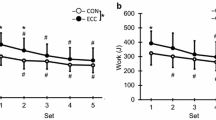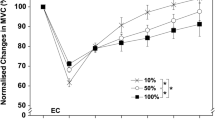Abstract
Purpose
The purpose of this study was to investigate the contralateral and ipsilateral repeated bout effects of eccentric contractions (ECCs) on muscle fiber activation using transverse relaxation time (T2) of magnetic resonance imaging (MRI).
Methods
Eleven men (22.3 ± 2.9 years) performed two bouts of 30 maximal ECCs of the elbow flexors spaced 2 weeks apart. Initially, all subjects performed 30 ECCs for one arm (ECC1). After 2 weeks, they performed 30 ECCs for both ipsilateral arm (IL-RBE) and contralateral arm (CL-RBE). Measurements were maximal voluntary isometric contraction (MVC) torque, range of motion (ROM), muscle soreness, cross-sectional area (CSA), and T2 at before, immediately after, 1, 2, 3, and 5 days after ECCs.
Results
The loss of MVC torque, limited ROM, and developed muscle soreness and CSA were inhibited for IL-RBE and CL-RBE compared with ECC1 (p < 0.05). The acute T2, which is an indicator of the activation of muscle fibers, was longer for IL-RBE and CL-RBE than ECC1 (p < 0.05). Otherwise, no significant difference between IL-RBE and CL-RBE was observed in other measurements.
Conclusion
Our results suggest that one of the mechanisms for CL-RBE of ECCs is the increase in muscle fiber activation. In addition, the magnitude of protective effect for CL-RBE was similar to the IL-RBE in untrained young men.




Similar content being viewed by others
Abbreviations
- ANOVA:
-
Analysis of variance
- CL-RBE:
-
Contralateral repeated bout effects
- CSA:
-
Cross-sectional area
- DOMS:
-
Delayed-onset muscle soreness
- ECCs:
-
Eccentric contractions
- IL-RBE:
-
Ipsilateral repeated bout effects
- MRI:
-
Magnetic resonance imaging
- MVC:
-
Maximal voluntary isometric contraction
- RBE:
-
Repeated bout effects
- ROM:
-
Range of motion
- T2:
-
Transverse relaxation time
- VAS:
-
Visual analog scale
References
Adams GR, Duvoisin MR, Dudley GA (1992) Magnetic resonance imaging and electromyography as indexes of muscle function. J Appl Physiol (1985) 73(4):1578–1583
Adams GR, Harris RT, Woodard D, Dudley GA (1993) Mapping of electrical muscle stimulation using MRI. J Appl Physiol (1985) 74(2):532–537. https://doi.org/10.1152/jappl.1993.74.2.532
Akima H (2012) Evaluation of functional properties of skeletal muscle using functional magnetic resonance imaging (fMRI). J Phys Fit Sports Med 1(4):621–630
Carroll TJ, Herbert RD, Munn J, Lee M, Gandevia SC (2006) Contralateral effects of unilateral strength training: evidence and possible mechanisms. J Appl Physiol (1985) 101(5):1514–1522. https://doi.org/10.1152/japplphysiol.00531.2006
Chen TC, Chen HL, Lin MJ, Wu CJ, Nosaka K (2009) Muscle damage responses of the elbow flexors to four maximal eccentric exercise bouts performed every 4 weeks. Eur J Appl Physiol 106(2):267–275. https://doi.org/10.1007/s00421-009-1016-7
Chen TC, Lin KY, Chen HL, Lin MJ, Nosaka K (2011) Comparison in eccentric exercise-induced muscle damage among four limb muscles. Eur J Appl Physiol 111(2):211–223. https://doi.org/10.1007/s00421-010-1648-7
Chen TC, Chen HL, Lin MJ, Yu HI, Nosaka K (2016) Contralateral repeated bout effect of eccentric exercise of the elbow flexors. Med Sci Sports Exerc 48(10):2030–2039. https://doi.org/10.1249/MSS.0000000000000991
Clarkson PM, Hubal MJ (2002) Exercise-induced muscle damage in humans. Am J Phys Med Rehabil 81(11 Suppl):S52–S69. https://doi.org/10.1097/01.phm.0000029772.45258.43
Clarkson PM, Sayers SP (1999) Etiology of exercise-induced muscle damage. Can J Appl Physiol 24(3):234–248
Clarkson PM, Nosaka K, Braun B (1992) Muscle function after exercise-induced muscle damage and rapid adaptation. Med Sci Sports Exerc 24(5):512–520
Herzog W (2014) Mechanisms of enhanced force production in lengthening (eccentric) muscle contractions. J Appl Physiol (1985) 116(11):1407–1417. https://doi.org/10.1152/japplphysiol.00069.2013
Howatson G, van Someren KA (2007) Evidence of a contralateral repeated bout effect after maximal eccentric contractions. Eur J Appl Physiol 101(2):207–214. https://doi.org/10.1007/s00421-007-0489-5
Hyldahl RD, Chen TC, Nosaka K (2017) Mechanisms and mediators of the skeletal muscle repeated bout effect. Exerc Sport Sci Rev 45(1):24–33. https://doi.org/10.1249/jes.0000000000000095
Isner-Horobeti ME, Dufour SP, Vautravers P, Geny B, Coudeyre E, Richard R (2013) Eccentric exercise training: modalities, applications and perspectives. Sports Med 43(6):483–512. https://doi.org/10.1007/s40279-013-0052-y
Kidgell DJ, Frazer AK, Daly RM, Rantalainen T, Ruotsalainen I, Ahtiainen J, Avela J, Howatson G (2015) Increased cross-education of muscle strength and reduced corticospinal inhibition following eccentric strength training. Neuroscience 300:566–575. https://doi.org/10.1016/j.neuroscience.2015.05.057
Kinugasa R, Kawakami Y, Fukunaga T (2006) Quantitative assessment of skeletal muscle activation using muscle functional MRI. Magn Reson Imaging 24(5):639–644. https://doi.org/10.1016/j.mri.2006.01.002
Kinugasa R, Kawakami Y, Sinha S, Fukunaga T (2011) Unique spatial distribution of in vivo human muscle activation. Exp Physiol 96(9):938–948. https://doi.org/10.1113/expphysiol.2011.057562
Kouzaki K, Nosaka K, Ochi E, Nakazato K (2016) Increases in M-wave latency of biceps brachii after elbow flexor eccentric contractions in women. Eur J Appl Physiol 116(5):939–946. https://doi.org/10.1007/s00421-016-3358-2
Lee M, Carroll TJ (2007) Cross education: possible mechanisms for the contralateral effects of unilateral resistance training. Sports Med 37(1):1–14
McHugh MP (2003) Recent advances in the understanding of the repeated bout effect: the protective effect against muscle damage from a single bout of eccentric exercise. Scand J Med Sci Sports 13(2):88–97
McHugh MP, Connolly DA, Eston RG, Gleim GW (1999) Exercise-induced muscle damage and potential mechanisms for the repeated bout effect. Sports Medicine 27(3):157–170
Munn J, Herbert RD, Gandevia SC (2004) Contralateral effects of unilateral resistance training: a meta-analysis. J Appl Physiol (1985) 96(5):1861–1866. https://doi.org/10.1152/japplphysiol.00541.2003
Munn J, Herbert RD, Hancock MJ, Gandevia SC (2005) Training with unilateral resistance exercise increases contralateral strength. J Appl Physiol (1985) 99(5):1880–1884. https://doi.org/10.1152/japplphysiol.00559.2005
Newton MJ, Morgan GT, Sacco P, Chapman DW, Nosaka K (2008) Comparison of responses to strenuous eccentric exercise of the elbow flexors between resistance-trained and untrained men. J Strength Cond Res 22(2):597–607. https://doi.org/10.1519/JSC.0b013e3181660003
Newton MJ, Sacco P, Chapman D, Nosaka K (2013) Do dominant and non-dominant arms respond similarly to maximal eccentric exercise of the elbow flexors? J Sci Med Sport 16(2):166–171. https://doi.org/10.1016/j.jsams.2012.06.001
Nosaka K, Clarkson PM (1996) Changes in indicators of inflammation after eccentric exercise of the elbow flexors. Med Sci Sports Exerc 28(8):953–961
Nosaka K, Sakamoto K (2001) Effect of elbow joint angle on the magnitude of muscle damage to the elbow flexors. Med Sci Sports Exerc 33(1):22–29
Ochi E, Tsuchiya Y, Nosaka K (2016) Differences in post-exercise T2 relaxation time changes between eccentric and concentric contractions of the elbow flexors. Eur J Appl Physiol 116(11–12):2145–2154. https://doi.org/10.1007/s00421-016-3462-3
Peake J, Nosaka K, Suzuki K (2005) Characterization of inflammatory responses to eccentric exercise in humans. Exerc Immunol Rev 11:64–85
Perez MA, Cohen LG (2008) Mechanisms underlying functional changes in the primary motor cortex ipsilateral to an active hand. J Neurosci 28(22):5631–5640. https://doi.org/10.1523/jneurosci.0093-08.2008
Starbuck C, Eston RG (2012) Exercise-induced muscle damage and the repeated bout effect: evidence for cross transfer. Eur J Appl Physiol 112(3):1005–1013. https://doi.org/10.1007/s00421-011-2053-6
Tsuchiya Y, Kikuchi N, Shirato M, Ochi E (2015) Differences of activation pattern and damage in elbow flexor muscle after isokinetic eccentric contractions. Isokinet Exerc Sci 23(3):169–175
Tsuchiya Y, Yanagimoto K, Nakazato K, Hayamizu K, Ochi E (2016) Eicosapentaenoic and docosahexaenoic acids-rich fish oil supplementation attenuates strength loss and limited joint range of motion after eccentric contractions: a randomized, double-blind, placebo-controlled, parallel-group trial. Eur J Appl Physiol 116(6):1179–1188. https://doi.org/10.1007/s00421-016-3373-3
Vigotsky AD, Halperin I, Lehman GJ, Trajano GS, Vieira TM (2017) Interpreting signal amplitudes in surface electromyography studies in sport and rehabilitation sciences. Front Physiol 8:985. https://doi.org/10.3389/fphys.2017.00985
Warren GL, Hermann KM, Ingalls CP, Masselli MR, Armstrong RB (2000) Decreased EMG median frequency during a second bout of eccentric contractions. Med Sci Sports Exerc 32(4):820–829
Xin L, Hyldahl RD, Chipkin SR, Clarkson PM (2014) A contralateral repeated bout effect attenuates induction of NF-kappaB DNA binding following eccentric exercise. J Appl Physiol (1985) 116(11):1473–1480. https://doi.org/10.1152/japplphysiol.00133.2013
Author information
Authors and Affiliations
Contributions
YT, KN and EO conceived the study. YT and EO participated in the design and coordination of the study. YT carried out the data collection and performed the statistical analysis. KN and EO helped to draft the manuscript. All authors read and approved the final manuscript.
Corresponding author
Ethics declarations
Conflict of interest
The authors declare that they have no conflict of interest.
Additional information
Communicated by William J. Kraemer.
Electronic supplementary material
Below is the link to the electronic supplementary material.
421_2018_3933_MOESM1_ESM.docx
Supplemental Digital Content 1. Figure that illustrates the changes (mean ± SD) in muscle damage after eccentric contractions at initial session (ECC1) in both arms (DOCX 1545 KB)
Rights and permissions
About this article
Cite this article
Tsuchiya, Y., Nakazato, K. & Ochi, E. Contralateral repeated bout effect after eccentric exercise on muscular activation. Eur J Appl Physiol 118, 1997–2005 (2018). https://doi.org/10.1007/s00421-018-3933-9
Received:
Accepted:
Published:
Issue Date:
DOI: https://doi.org/10.1007/s00421-018-3933-9




